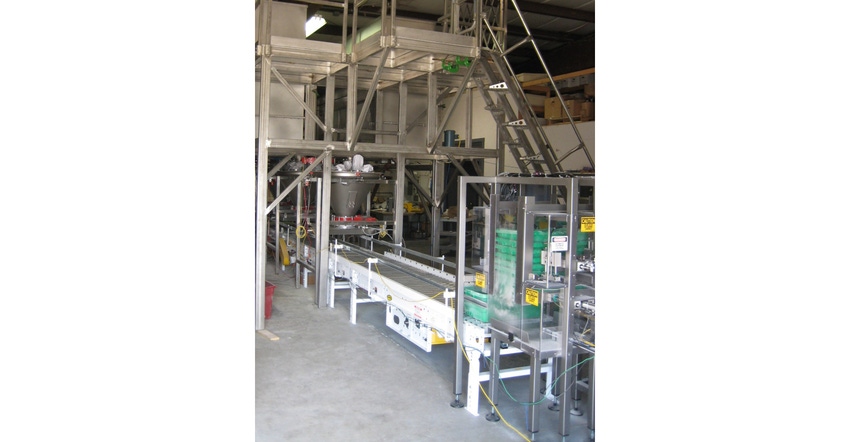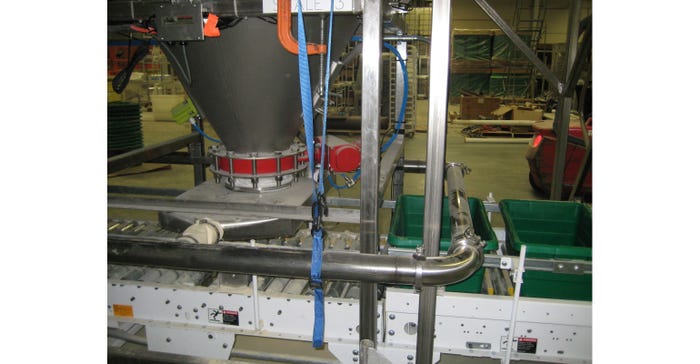A Custom-Engineered Ingredient Batching System Can Be a Game-Changer
These systems can help facilities achieve a significant boost in productivity, consistency, and profitability.
January 25, 2024

Automatic ingredient batching systems can improve your production and increase quality through consistency and profitability. The best of these systems will be custom engineered to fit the specific objectives and application requirements for your process and facility. This necessitates a high level of expertise with process, data management, and electrical, mechanical, and control/automation technologies.
Many aspects of an automatic ingredient batching system require tailoring to your specific objectives and process. You will need to help define:
Ingredients to be included: Information about the ingredients including bulk density and minimum/maximum weighments within your recipes/formulas are needed.
Example recipes/formulas: Example recipes/formulas are needed to show the amounts of each ingredient used. This will impact the size of storage bins.
How each ingredient is supplied: Do you purchase each ingredient in small bags (40/50/80 lb, etc.) by the pallet, by FIBC bulk bags, or totes? Is storage for pallets to be within easy reach of the ingredient storage containers desired? If ingredients are purchased in bulk bag or bulk tote, then customized bag/tote unloaders will be needed.
Batch rate: What is the objective batching rate you need for current and future production? This will impact ingredient storage, feeder sizing, the sizing and quantity of scales, and more. This is key to understanding the ROI you can expect.
Dust: If ingredient materials are dusty then dust hoods may be needed over batch containers and storage bins. A suitable dust collection system might be required and custom engineered/integrated into the system.
Conveyance: What is the process step after batching? How will the batches be delivered to the next step? Some applications may require the batching system to automatically deliver batches to the next step (a mixer). The conveying could be pneumatic or mechanical means. The batches may also be collected in small totes, then manually taken to the next step.
Footprint/height limits: How much space do you have available for the batching system? What is the shape of the space available? Is there a height limitation?
Special adaptations: Features or adaptations specific to your process or facility might be required. Custom engineering the ingredient batching system is essential. Let’s look at an example where the specialized ��“denesting” of small totes was required.
Denesting Totes in Ingredient Batching System
Small totes are often used to collect ingredient batches. The totes are manually delivered to the next step (such as a mixer). The batching system supplier also provides the system controls/automation and will provide the necessary ingredient lot tracking and batch validation. Advanced data management expertise is required.
When batches are delivered and validated at the consumption location, the batch tag (such as RFID tags) may be scanned in a “use station” provided by the system supplier, for validation purposes. Empty totes are usually stacked and returned to the beginning of the batching system line. The totes get stuck together when stacked. This is referred to as being “nested”. For empty totes to be used they must first be “denested.” This system does this automatically.
This specific application example is batching food ingredients. The ingredient batching system includes 14 storage bins constructed of food-grade stainless steel. The ingredient bins vary in size, including six 12-cu-ft bins, two 18-cu-ft bins, two 31-cu-ft bins, and four 39-cu-ft bins. The system is designed to fill more than 700 totes per shift (eight hours). That is 1-2 totes per minute fully batched with ingredients for the recipe being run.
Return on Investment
The previous method of batching was manual. It required three shifts with two employees batching ingredients per shift. With the ingredient batching system this manual labor and shifts were significantly reduced (a single-shift batching system exceeded the capacity of the previous three-shift manual system).
The totes “nested” together must be denested before they could be used for a new batch of ingredients. Denesting totes requires a special machine to be integrated up front into the batching system. Figure 1 shows a portion of the denesting machine section.
To provide a custom-engineered batching rate of 1-2 batches per minute necessitated multiple scale hoppers. Each scale hopper was fed with several ingredients. Multiple totes were able to be processed at the same time. Each tote was approximately 1.6 cu ft.
The ingredients were powders. They created high levels of dust when being fed into the totes or poured from their bags into storage bins. This required dust takeoffs and collection hoods, and a dust collection system. Figure 2 shows a dust hood at the discharge of one of the scale hoppers.
I

Figure 2: Dust hood at scale hopper discharge
The ingredient batching system prepares accurately weighed batches, increasing production throughput while minimizing labor. The procedure for operating this type of custom-engineered batching system is as follows. Tailoring the sequence of operation for a custom system is important:
1. The operator selects the desired recipe to be batched from the system controls. Recipes can be programmed during system setup, or through integration with an ERP system. The desired number of batches for the recipe is also selected.
2. When the recipe is selected, the quantity of batches verified, and the nested totes are in the denesting section of the system, the system is started by an operator. The system automatically denests each tote and indexes each tote to the scales one after the other. The system eliminates empty scaling positions and maximizes throughput.
3. The batching controls automatically starts each ingredient feeder. The feeders used are auger/screw-type feeders. Each feeder has two-speed control (fast fill, slow dribble) for optimizing weighment accuracy.
4. After the ingredients are discharged from the scale hoppers into the totes, they will be indexed to the next scale hopper and so forth until completed. The totes are then indexed to the unloading position. The system will continue this sequence until all required batches are complete.
5. For maximum throughput the system simultaneously weighs into the three scale hoppers – one ingredient per scale at a time. Once the totes have completed collecting ingredients at each of the scale hoppers, the totes are conveyed to the unloading point.
The custom-engineered control system utilizes data management to provide real-time records of ingredient lots for each batch produced. This enables the highest standards ensuring a consistent and correct end-product. The controls record the batch data to the system database. It can print batch reports. These reports provide each ingredient by identification along with the required/actual formula weights, and the time and date for the batch. Custom-engineered system controls can include recipe management, inventory control, ingredient lot tracking, batch validation, ERP integration, supervisory control, and alarm/event monitoring and reporting. Preventative maintenance planning can also be provided.
Conclusion
A custom-engineered ingredient batching system can be a game-changer for your process and production, no matter what your industry. With its meticulous design and attention to detail, the system can be seamlessly integrated into your production process, thereby elevating the quality, consistency, and efficiency of the product, and entire operation.
The initial step of gathering technical information is crucial for tailoring the system to your specific needs. Ingredients, their bulk density, and weighments, along with example recipes, should be known and documented. The supplier of the ingredient batching system will combine its team with yours to consider how each ingredient was supplied, the desired batch rate, potential dust concerns, conveyance requirements, and any spatial limitations.
The above example of a custom-engineered ingredient weighing and batching system exemplifies why custom solutions are required and the results they can deliver. In this case, the incorporation of a denesting machine for the totes in the ingredient batching system, dust containment and collection, and more was required. This batching system ensured that the totes, crucial for collecting individual batches, were efficiently denested and ready for use in subsequent cycles. The 14-bin system, constructed of food-grade stainless steel, accommodated various ingredient storage bin sizes, catering to the diverse needs of producing the desired recipes.
The system's custom-engineered approach allowed it to fill more than 700 totes in a single eight-hour shift, achieving a remarkable rate of 1-2 batches produced per minute. Multiple scale hoppers, each handling several ingredients simultaneously, further optimized the batching process. The dusty nature of some ingredients prompted the inclusion of dust hoods and a dust collection system to maintain a clean environment during the feeding and bin filling processes.
Operating the system was a streamlined procedure. The operator easily selects a preprogrammed recipe from the controls, and the system denested totes, indexed them to the scales, and initiated ingredient feeding. Auger/screw-type feeders with two-speed control ensured precise weighments. The system continued this sequence until the desired number of batches was completed.
The robust custom-engineered control system, equipped with superior data management, provided real-time records of ingredient lots for each batch. Batch reports, detailing ingredient identification, required and actual weights, and timestamp, were generated. The system automation can encompass recipe management, inventory control, ingredient lot tracking, batch validation, ERP integration, supervisory control, alarm/event monitoring, reporting, and preventative maintenance planning.
In the end, a food or other type of production facility can witness a significant boost in productivity, consistency, and profitability. The custom-engineered ingredient batching system can meet or exceed specific objectives becoming an indispensable asset in the pursuit of production excellence.
Joe Lewis is marketing manager, Sterling Systems & Controls Inc. (Sterling, IL). For more information, call 815-625-0852 or visit www.sterlingcontrols.com.
You May Also Like


